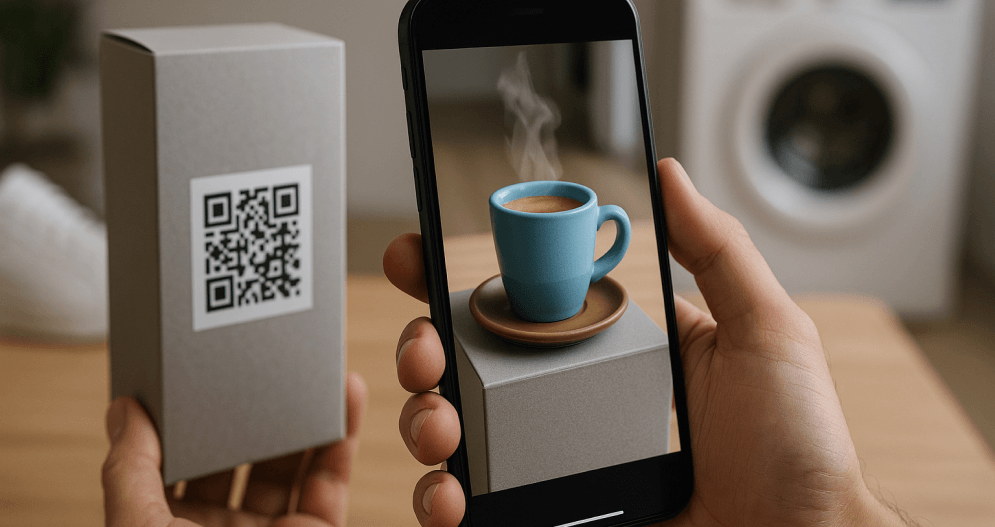Imagine pointing your phone at a product and instantly watching it come to life. Steam rises from a virtual coffee cup. A sneaker changes color on command. A washing machine shows its complete cycle with animated overlays. That’s not a gimmick. It’s the new reality of marketing.
More and more brands are using augmented reality for marketing campaigns. The reason is simple: it’s not just more fun; it performs better. AR technology bridges the gap between a brand’s message and a customer’s experience in a way no static medium can.
Let’s explore what makes it effective, how it works, and what it takes to get started.
What makes AR different from traditional marketing?
Traditional marketing often involves sending a message into the world and hoping it lands through billboards, TV ads, or print materials. Augmented reality flips the script by inviting people to participate.
With AR, people can scan a product label and unlock an interactive story. They can hold their phone up to a poster and see it move. Or use an AR filter to try on sunglasses virtually. The point is, it’s no longer just a message. It’s an experience.
This interactivity builds stronger connections. Customers don’t just see a product. They explore it, test it, and remember it.
That shift from passive viewer to active participant is what sets AR apart from traditional marketing.
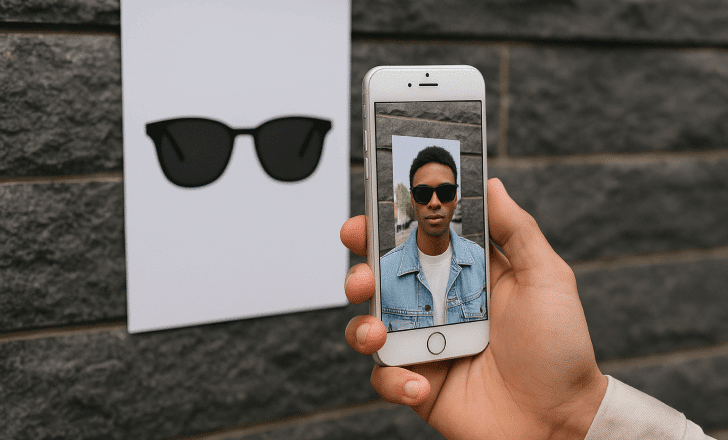
What is augmented reality marketing, and how is it evolving?
Augmented reality marketing is more than a trend; it’s a shift in how brands deliver digital content and connect with audiences. It blends physical and digital touchpoints to create interactive, personalized experiences.
Whether it’s an AR filter on social media or an interactive product demo in a retail app, AR marketing gives users something they can control, explore, and remember.
What sets this format apart is how naturally it integrates into daily behavior. Users already rely on mobile devices for shopping, entertainment, and communication.
By adding spatial, digital elements into that flow, augmented reality marketing makes the brand experience more immediate and more impactful. As expectations for personalization and instant engagement grow, AR technology is evolving from a novelty into a core tool for digital storytelling.
How are brands using AR in real campaigns?
Let’s look at a few standout examples.
Pepsi Max ran an AR campaign at a London bus shelter, making it look like alien ships, robots, and wild animals were roaming the streets. It was surreal and unforgettable.
Coca-Cola created an AR concert experience triggered by scanning special packaging. Customers could launch a show from their phones.
Retailers like IKEA and Sephora have used AR to help customers visualize furniture and makeup in their real environments.
These campaigns didn’t just get attention. They encouraged interaction, sparked social shares, and increased purchase intent.
AR gives people something to talk about and, more importantly, a reason to stay engaged.
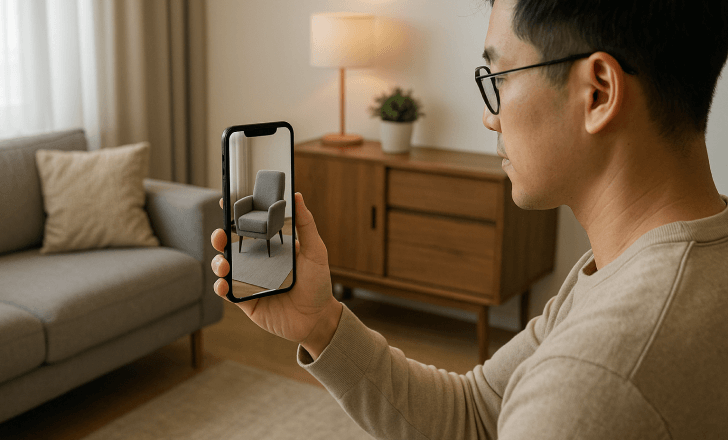
What are the core benefits of AR marketing?
The most substantial benefit of augmented reality is simple: it makes people care.
Instead of just watching a video or reading an ad, customers participate. That makes them spend more time with your brand.
It also improves their understanding of the product since they can explore features, sizing, and fit hands-on.
On an emotional level, AR marketing experiences leave a stronger impression because they don’t just show. They surprise, entertain, and inform. And because these experiences are memorable, they’re also more likely to be shared.
There’s also a practical benefit. You can track how users interact with your AR experiences. Unlike traditional ads, where insights are often limited to views or clicks, AR lets you measure where users look, what they touch, how long they stay, and where they drop off.
That kind of feedback is gold for refining your campaigns.
Why augmented reality advertising outperforms static formats
Augmented reality advertising creates space for interaction where traditional ads fall short. Instead of being seen once and forgotten, AR ads invite users to pause, move, tap, and react.
Whether they’re trying on sneakers in AR, scanning an ad in a magazine, or viewing a product in their own space, they’re participating, not just watching.
This matters because user engagement is no longer optional. With millions of impressions scrolling by every day, smartphone users now expect more. AR ads respond to that shift by providing richer, more immersive experiences with measurable impact.
Studies have shown that AR campaigns lead to higher recall, increased purchase intent, and longer time-on-screen than banner ads or video alone.
Is AR just a gimmick, or does it driv
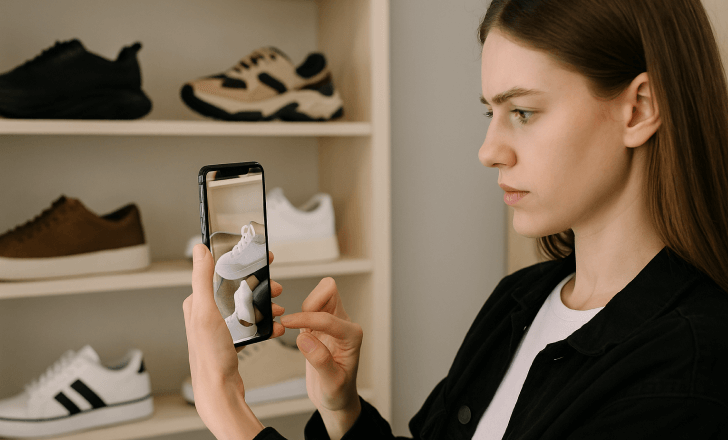
e results?
It might sound flashy, but augmented reality gets serious results.
Studies show that AR ads often outperform standard video or display ads regarding attention, recall, and conversion. Why? AR doesn’t just show; it helps people decide.
For example, a user might be browsing kitchen appliances online. With AR, they can project a virtual blender onto their countertop, adjust the color, rotate it, and even explore features through interactive product demonstrations.
That experience answers their questions, reduces doubt, and builds confidence in the purchase.
So no, AR isn’t a gimmick. Executing with a clear goal and thoughtful design becomes a practical part of the customer journey.
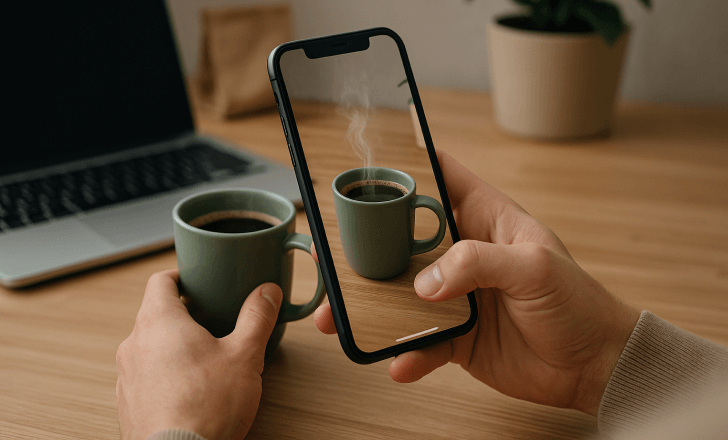
What kind of AR experiences can I create?
One of the most accessible and versatile formats today is WebAR, which often incorporates markerless AR. Unlike traditional marker-based AR, which requires an app download, WebAR launches right from the browser. Users click a link or scan a QR code with their smartphone camera and are instantly immersed in an AR experience with no friction or extra steps.
With WebAR, brands can create virtual try-ons, interactive packaging, product previews, and branded games that work across nearly all smartphones.
A cosmetics company might let users try on lipstick shades using only their front-facing camera.
A furniture brand can show customers how a new chair would look in their living room with just a single tap.
A food brand could turn a cereal box into a portal for mini-games, nutrition info, or an interactive recipe demo.
Because WebAR lives in the browser, it’s also incredibly scalable. You can embed it in an email, share it on social media, or integrate it into your website. It works seamlessly across platforms and gives users instant access.
App-based AR, by comparison, often struggles to match that kind of reach and immediacy.
At RealityMAX, we’ve focused on making WebAR creation simple, so marketers can design these experiences themselves, test quickly, and go live without delays or dev time.
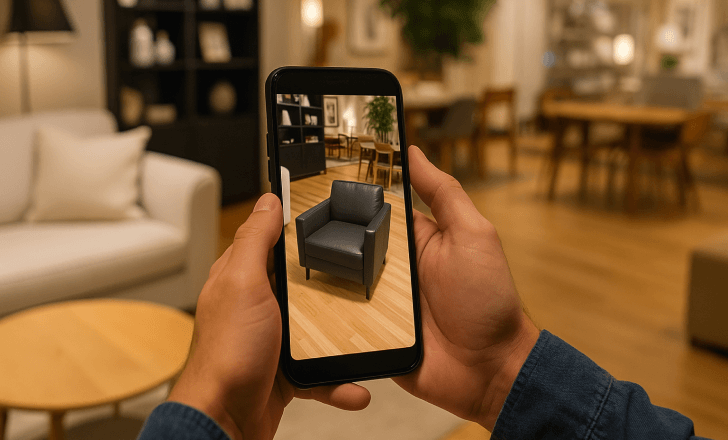
How do QR codes fit into AR marketing?
QR codes are often the gateway to augmented reality. They connect physical objects like posters, packaging, or brochures to digital experiences. A customer scans the code and instantly accesses an AR layer that adds movement, interaction, or information.
For example, a coffee brand might print a QR code on its takeaway cup. Scanning it could launch an animated tutorial about their bean-sourcing process. A toy could come with a code that opens a 3D virtual pet to play with.
This simple bridge between offline and online lets marketers activate products in the real world.
What’s possible with AR product packaging?
AR product packaging turns static surfaces into storytelling channels. By embedding digital experiences directly into the packaging, brands extend their message far beyond the shelf.
For example, scanning a cereal box might launch an interactive game for kids, while a “digital bottle” of wine could open a video about the vineyard’s history.
This type of AR experience adds value to the moment of unboxing or first use. It can deliver tutorials, immersive AR visuals, or even virtual elements like 3D recipes or coupons.
Importantly, it doesn’t require special hardware, just a smartphone and the right trigger. For CPG brands and direct-to-consumer businesses, AR product packaging is becoming a cost-effective way to boost customer engagement without reworking physical supply chains.
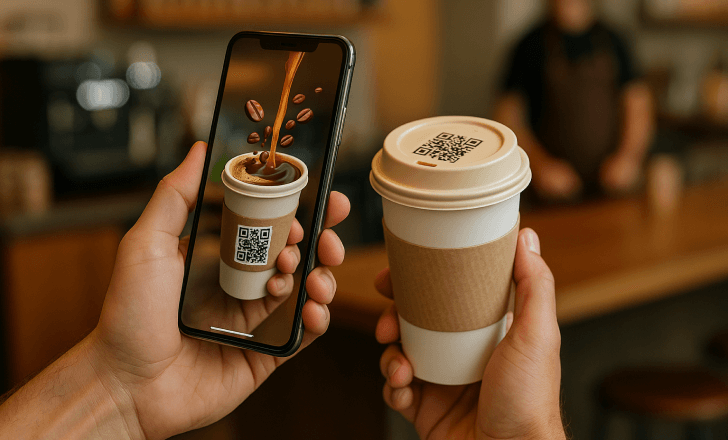
What industries are using AR the most?
AR marketing isn’t limited to one niche. It’s becoming more and more essential to various industries.
In retail and fashion, customers can try on clothes, makeup, or accessories virtually. Home decor and furniture companies use AR to help shoppers visualize products in their own space.
Packaging becomes interactive in the food and beverage sector and offers games, storytelling, or origin stories. Entertainment brands have started launching teasers and trailers as immersive experiences that turn movie posters into digital portals.
Automotive brands use AR to showcase products, simulate test drives, or explore car features directly on a mobile screen. In CPG and cosmetics, AR campaigns support product launches with hands-on previews and branded filters.
AR is proving its value wherever products need context, interactivity, or demonstration.
How experiential marketing is changing with AR
Experiential marketing used to mean pop-up stores, in-person demos, or splashy launch events. Augmented reality has expanded what’s possible without needing large physical footprints.
An immersive AR experience can deliver the same impact through a phone screen, reaching more people with lower costs and fewer logistics.
A product launch, for example, can include an AR teaser that lets users preview new items at home. A campaign might feature an AR concert, a scavenger hunt, or a virtual showroom, all accessible through mobile devices. These experiences can be live or evergreen, allowing brands to extend excitement beyond the launch moment.
Because they feel personal and memorable, AR-driven experiential campaigns often lead to better social engagement and word-of-mouth sharing than traditional events.
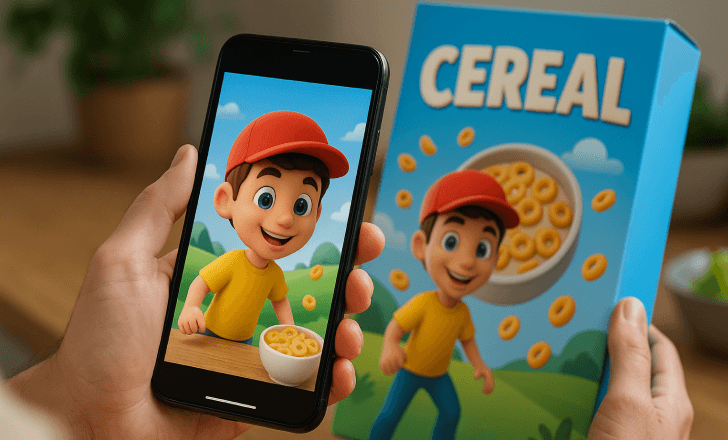
What makes an AR campaign successful?
It’s not about doing something wild or futuristic; it’s about integrating AR into your next marketing campaign. The best AR marketing campaigns are rooted in a clear strategy.
The starting point is always your goal. Are you trying to raise awareness, drive purchases, or build brand loyalty? From there, everything flows: creative direction, tech stack, placement, and tone.
The most effective campaigns find a balance between entertainment and utility. For instance, letting users spin a 3D model of your product is interesting.
It is even more helpful if you let them see it in their kitchen or learn how it works in 30 seconds. These memorable experiences should be quick to launch, intuitive to explore, and rewarding to complete.
Whether you’re building hype or solving a problem, your AR experience should feel like it belongs in the user’s day rather than being a detour.
How augmented reality technology fits into a broader marketing strategy
An effective marketing strategy doesn’t treat AR as an isolated stunt. Instead, it integrates AR with broader marketing goals like product education, customer acquisition, or brand differentiation.
Augmented reality can act as a top-of-funnel awareness tool, a mid-funnel explainer, or even a post-purchase engagement layer, depending on how it’s deployed.
Start with your audience. Are they already engaging with your brand online? Are they mobile-first shoppers? Are they seeking customization or information before purchase? Then define what the AR interactive experience should achieve. Should it guide, entertain, inform, or convert?
AR becomes a smart and flexible layer in a multi-channel strategy when aligned with purpose. It can be reused across social media platforms, in-store activations, and email campaigns, giving you more return on each asset you create.
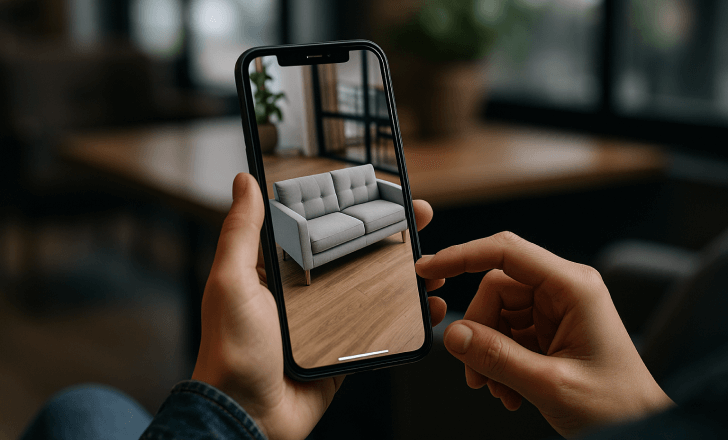
Can AR replace traditional mediums or work alongside them?
AR isn’t here to eliminate traditional mediums, but to enhance them. While banner displays and video ads still play essential roles in awareness, they now compete with more interactive formats. Augmented reality lets marketers build on those formats instead of replacing them entirely.
For example, a print ad in a magazine can include a marker that triggers a 3D experience. A product video on social media can be paired with an AR filter that invites users to “try before they buy.”
These hybrid strategies combine the reach of traditional media with the engagement of AR, helping campaigns achieve both scale and emotional impact.
In short, AR isn’t a competitor to traditional channels. It’s a force multiplier.
What role does RealityMAX play in all of this?
RealityMAX helps make all of the above possible without the technical headaches.
You upload your product image, choose your augmented reality format, and customize the experience in an intuitive workspace.
There’s no app building or complicated 3D software involved. Just innovative tools and AI-powered image enhancement that help you go from concept to campaign in hours, not weeks.
Whether you want to create an AR filter for a launch event, show your product in a virtual environment, or build an entire catalog of AR assets, we’ve got you covered.
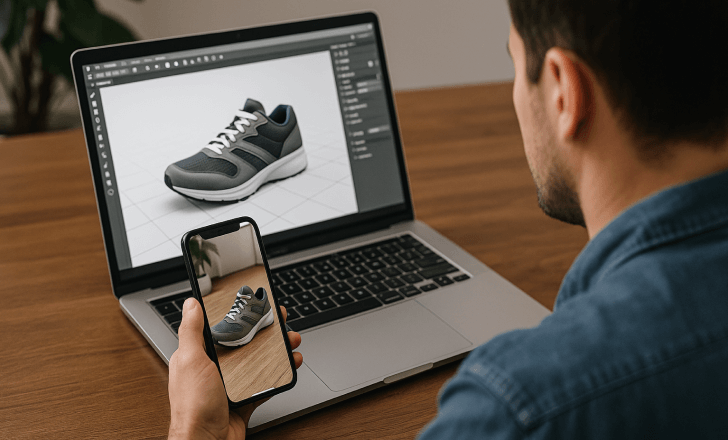
What’s the future of AR in marketing?
We’re seeing the start of a shift. The novelty fades as smartphone users get used to augmented reality features in shopping, social apps, and everyday life. What remains is the usefulness.
Augmented reality isn’t the future anymore. It’s already here. It’s how brands show, explain, create meaningful connections, and sell in an increasingly digital world.
And for teams that want to move fast, create with confidence, and stay ahead of the curve, it’s one of the most powerful tools available.
With RealityMAX, that tool is finally within reach.
